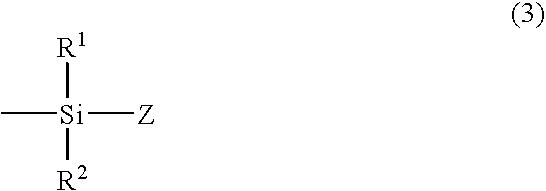Production process for silsesquioxane derivative having functional group and silsesquioxane derivative
a technology of functional groups and silsesquioxane, which is applied in the field of production process of silsesquioxane derivatives and silsesquioxane derivatives, can solve the problems of not being incorporated into the part to be modified by reaction, unable to introduce, and loss of characteristics provided by adding silsesquioxane derivatives, etc., to achieve a high reactivity, promote reaction, and reduce production costs
- Summary
- Abstract
- Description
- Claims
- Application Information
AI Technical Summary
Benefits of technology
Problems solved by technology
Method used
Image
Examples
example 1
[0124]
[0125] A 1000-ml four-necked flask equipped with a reflux condenser, a thermometer and a dropping funnel was charged with phenyltrimethoxysilane (99 g), sodium hydroxide (10 g) and 2-propanol (500 ml). Deionized water (11 g) was added dropwise at a room temperature in about 2 minutes while stirring by means of a magnetic stirrer. Then, the solution was refluxed on an oil bath. Stirring was continued for 1.5 hour since refluxing started. Then the solution was cooled down at room temperature and left standing for 15 hours. Then product was precipitated. A stainless steel pressure filter equipped with a membrane filter having a pore diameter of 0.1 .mu.m was used to separate the precipitate. Then, the precipitate thus obtained was washed once with 2-propanol and dried at 70.degree. C. for 4 hours in a vacuum dryer to obtain 66 g of a white powder.
[0126]
[0127] A 50-ml three-necked flask equipped with a dropping funnel, a reflux condenser and a thermometer was charged with the wh...
example 2
[0129]
[0130] A 3000-ml three-necked flask equipped with a dropping funnel, a thermometer and a stirrer was charged with the compound (1-1) (249 g) produced by refering the method in Example 1 and toluene (2000 ml) and sealed under dry nitrogen. Chlorodimethylsilane (142 g) was added dropwise in about 50 minutes while stirring so that the solution temperature was maintained at 20 to 40.degree. C. After finishing dropwise addition, the flask was heated on an oil bath so that the solution temperature became 65.degree. C., and stirring was continued for 3 hours after the temperature reached 65.degree. C. Then the solution was cooled down became 50.degree. C. or lower, and then deionized water (230 g) was added dropwise in about 10 minutes. After finishing dropwise addition, stirring was continued for 10 minutes, and then, the reaction mixture was separated by means of a separating funnel, and the organic layer was repeatedly washed with each 200 g of deionized water, and then moisture ...
example 3
[0132] 5
[0133] A 50-ml two-necked flask equipped with a dropping funnel and a thermometer was charged with the compound (1-1) (1.0 g), THF (10 g) and triethylamine (0.9 g) and sealed under dry nitrogen. Chlorodiisopropylsilane (2.3 g) was added dropwise in about 10 seconds while stirring so that the solution temperature was maintained at 15 to 17.degree. C., and then stirring was continued at 15.degree. C. for 3 hours. Deionized water (10 g) was added dropwise to this reaction mixture in about one minute so that the solution temperature was maintained at 30 C or lower. After finishing dropwise addition, stirring was continued for 10 minutes, and the reaction mixture was separated by means of a separating funnel, and the organic layer was washed three times with each 10 g of deionized water. This organic layer was dried over MgSO.sub.4, filtered and evaporated to obtain 1.1 g of a white solid.
[0134] The white solid thus obtained was subjected to infrared absorption spectroscopy by th...
PUM
| Property | Measurement | Unit |
|---|---|---|
| mole ratio | aaaaa | aaaaa |
| reaction time | aaaaa | aaaaa |
| pore diameter | aaaaa | aaaaa |
Abstract
Description
Claims
Application Information
 Login to View More
Login to View More - R&D
- Intellectual Property
- Life Sciences
- Materials
- Tech Scout
- Unparalleled Data Quality
- Higher Quality Content
- 60% Fewer Hallucinations
Browse by: Latest US Patents, China's latest patents, Technical Efficacy Thesaurus, Application Domain, Technology Topic, Popular Technical Reports.
© 2025 PatSnap. All rights reserved.Legal|Privacy policy|Modern Slavery Act Transparency Statement|Sitemap|About US| Contact US: help@patsnap.com



